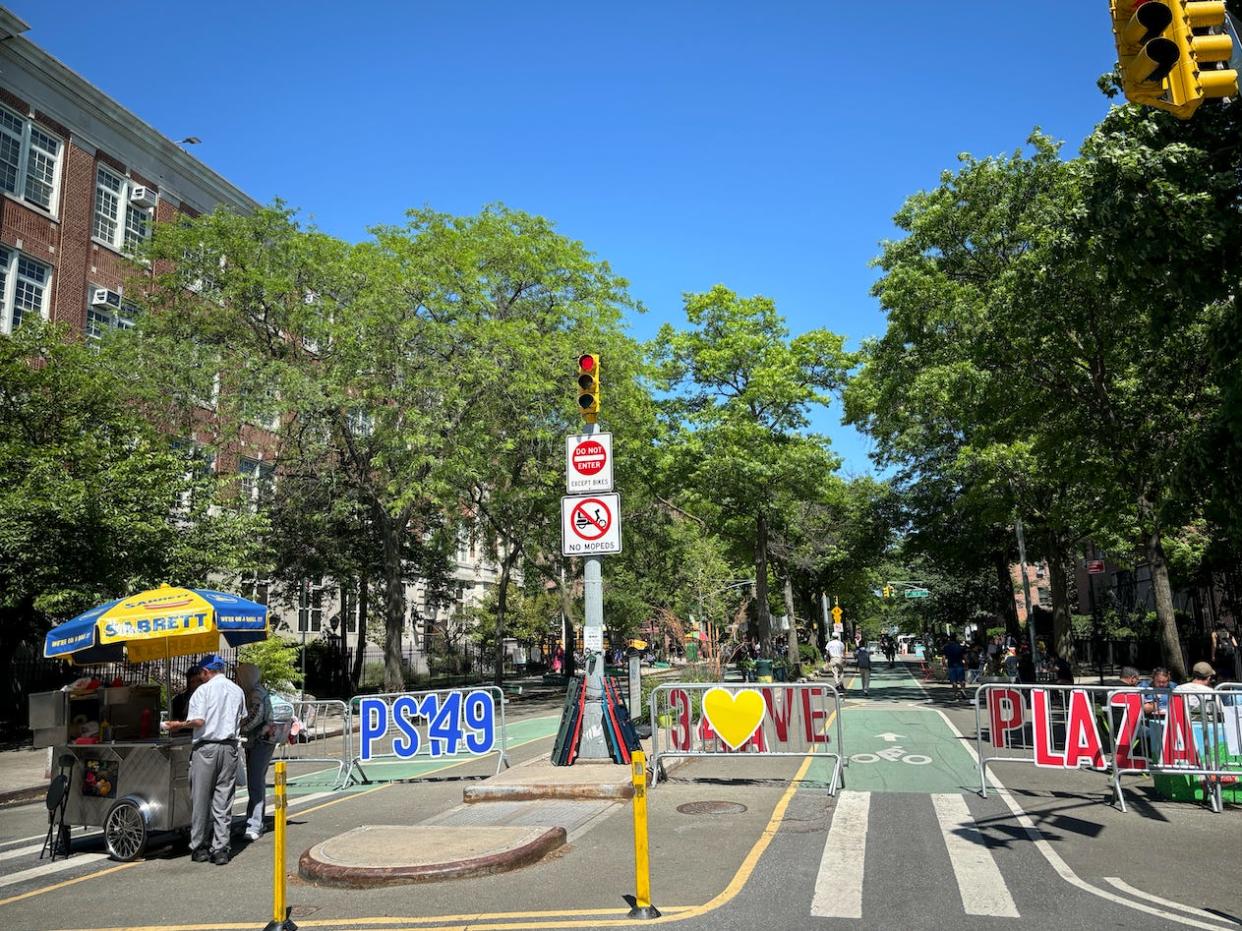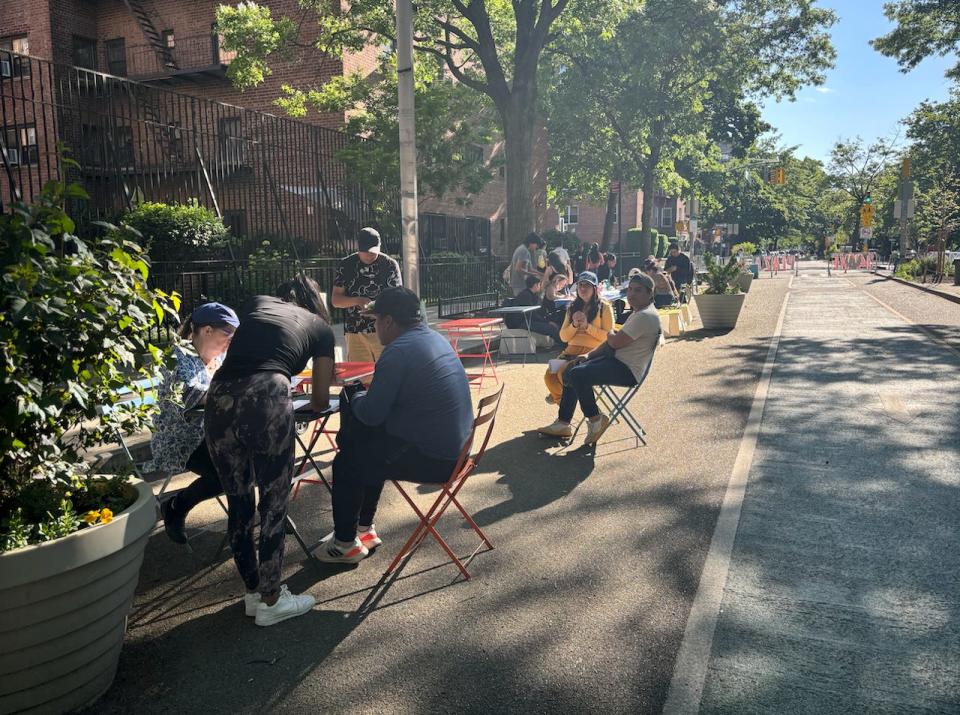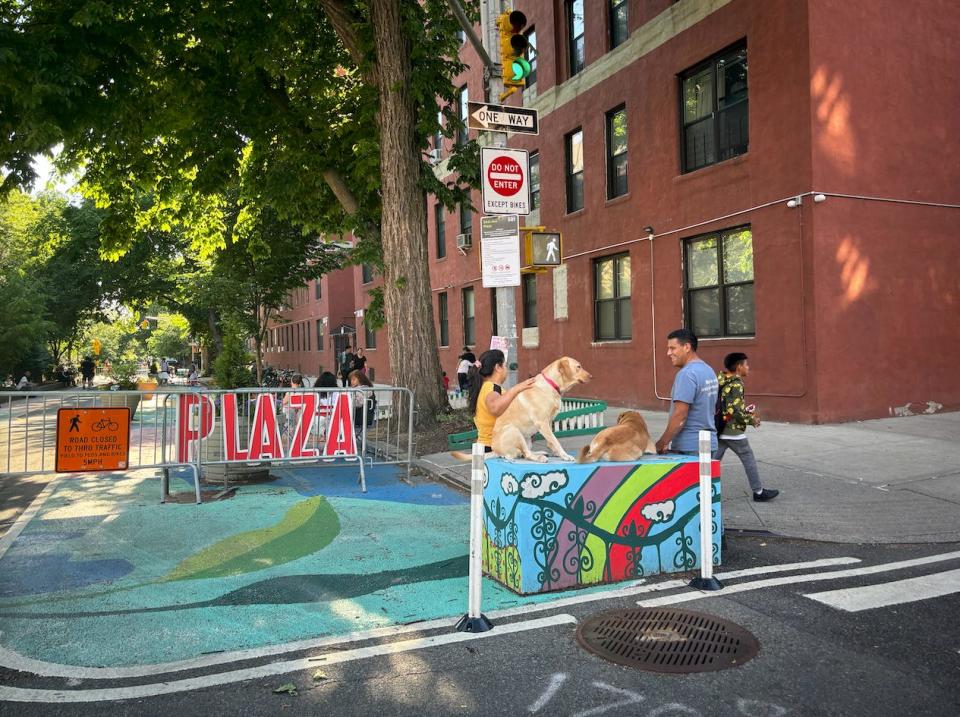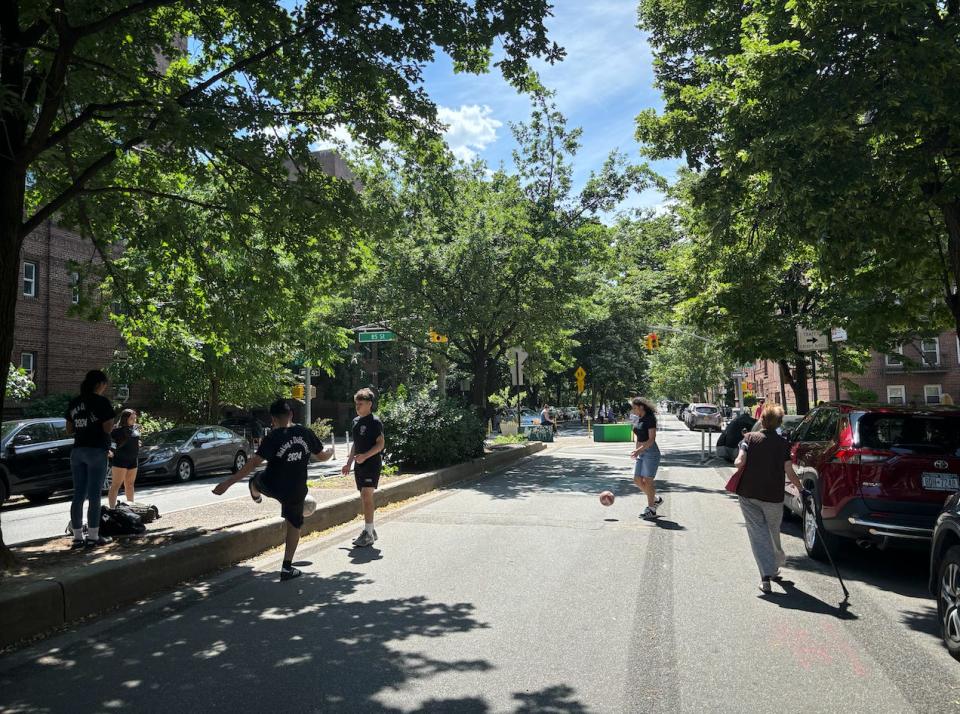A working-class immigrant neighborhood in Queens banned cars along a major road. The new park is a 'superhighway of kids and families and neighbors.'

The longest traffic-restricted "open street" in New York City is in Jackson Heights, Queens.
The working-class, predominantly immigrant neighborhood was an epicenter of COVID-19 in 2020.
With open streets closing and shrinking across the city, 34th Avenue offers a model of community engagement.
On a recent sunny Friday afternoon in Jackson Heights, Queens, dozens of migrants filled out applications for asylum at folding tables set up in the street outside a local elementary school. Former Manhattan prosecutor Nuala O'Doherty-Naranjo, who operates the free legal clinic three days a week, sat nearby answering questions.
In good weather, she and her team — all volunteers — hold the clinic in the street, which was recently transformed into a car-free public plaza. Steps away, kids played soccer, a little girl tested out the training wheels on her bicycle, and a neighbor led a free crocheting class.
Just a few years ago, that same road — 34th Avenue — was a traffic-clogged artery. But a years-long, grass-roots effort has turned a 1.3-mile-long, 26-block stretch of the avenue — which the city council renamed Paseo Park — into the crown jewel of New York City's embattled Open Streets Initiative.
As New York Gov. Kathy Hochul reverses the city's attempt to reduce congestion in Manhattan, Jackson Heights has managed to cement its open street into a feature the community isn't willing to give up.
Turning a dangerous street into a center of community
O'Doherty-Naranjo remembers that the principal of a public middle school on 34th Avenue — one of nine schools with thousands of students within about 35 blocks — had to direct traffic as kids filtered across the street at dismissal, fighting for space with drivers.
"Drivers would literally just scream and honk at the principal as a thousand kids are crossing the district," said O'Doherty-Naranjo, who was the president of the school's parent-teacher association.
Then, one afternoon in March 2019, a 12-year-old boy was hit and seriously injured by a driver in a Jeep outside another of 34th Avenue's middle schools. That tragedy spurred meetings between the schools, the police department, DOT, and safe street advocates to speed the process of restricting vehicle traffic during certain hours.

Not long after, the pandemic hit. Suddenly, schools were closed and traffic slowed to a trickle. Central Queens' working-class immigrant neighborhoods had become the "epicenter of the epicenter" of the virus. Nearby, Elmhurst Hospital Center became one of the hardest-hit medical centers in the country.
The lockdown also shed a harsh spotlight on the area's lack of green space. Jackson Heights has among the least amount of park space of any New York City neighborhood.
With people cooped up in small apartments, O'Doherty-Naranjo and a group of other neighbors decided to start pushing to restrict traffic along most of 34th Avenue. They got the go-ahead, but they needed manpower to enforce it. About 100 volunteers were soon recruited to help set up and take down metal barricades at each intersection every morning and night to block the street from through traffic.
These days, 34th Avenue is the neighborhood's public backyard. All pass-through vehicle traffic is prohibited between 7 am and 8 pm every day of the year, although cars can still park on all of the blocks that aren't plazas.
The blocks immediately outside each school are permanently vehicle-free, an increasingly popular safety measure around the world. Residents have cleaner air and quieter and safer streets, as well as a community space they desperately need. Traffic accidents on 34th Avenue involving pedestrians are down 61%, according to the City Department of Transportation, and crashes with injuries are down 34%.
On a Friday afternoon in late May, 19-year-old City College student Braulio Tellez hung out eating pizza with his mom and sister while perched on the tree-lined median that runs along the center of the open street. Tellez grew up in the neighborhood and sometimes carries his telescope out at night to observe the moon and planets from the quiet of the road.
"It helps remove all stress," Tellez said of the traffic-restricted street. "I love it."

A 'superhighway' of pedestrians and bikes
Jim Burke, a longtime pedestrian and transit advocate, had lived in his apartment building right on 34th Avenue for a dozen years when the pandemic hit. But he knew virtually none of his neighbors. In the early days of the pandemic, bored in their apartment, Burke and his partner started regularly playing a coin-tossing game in the street. Soon, neighbors and kids began joining in.
Burke grew up in the Bronx and the Rockaways and remembers that as kids, he and his friends "owned the streets," where they played every day. He figured adults and kids alike should have that same experience on 34th Avenue.
"One thing led to another and then we started raising money," Burke said. "People looked out their windows and said, 'Oh that looks like fun, I don't want to stay in my house for another minute.'"
O'Doherty-Naranjo and Burke co-founded the 34th Avenue Open Streets Coalition and used the funds they raised to put on programming — hiring yoga and Zumba instructors to teach free classes, volunteers to lead English lessons, and even enlisting doctors to dispense free medical advice. The effort was entirely volunteer-powered for the first 18 months before the city stepped in to help.
"In the summer, I see a lot of people doing activities, or going out, walking, kids playing with chalk — just cool things that I didn't have when growing up," said Yorladiz, a Jackson Heights native who regularly walks her four-year-old daughter up and down 34th Avenue. "It's yoga night, it's salsa night — they're always doing something."
These days, Burke can't spend more than a few minutes on 34th Avenue without running into a neighbor he knows.
"It's become this superhighway of kids and families and neighbors," O'Doherty-Naranjo said.
These days, controversy on 34th Avenue mostly concerns a surge in mopeds, which tend to use the street as a cut-through.
Shekar Krishnan, the councilman who represents the neighborhood, held a "Moped Crisis" town hall recently and says the City needs to come up with a plan to redesign the street to keep mopeds off of it and create safer ways for them to travel on other streets. If the Department of Transportation is going "to oversee the expansion of public space, in addition to their other work," Krishnan said, "they need to get far more serious, and ambitious, and creative in how they do so — and, frankly, listen to the communities."

Burke and O'Doherty-Naranjo don't want to ban mopeds from 34th Avenue. They recognize that other streets often aren't safe for moped drivers, many of whom are delivery workers.
Funding for open streets can be hard to come by, however. Across the city, 83 miles of open streets dwindled to about 20 miles between 2020 and 2022. DOT only allots $20,000 a year for 34th Avenue, Burke said, which is just a fraction of the funds needed to operate the open street all year round. The city has also been slow to reimburse neighborhood groups supporting open streets across the city.
Burke estimates 34th Avenue needs at least $50,000 a year to operate with a decent amount of programming — and the City still owes it $10,000 from last year. The more money the street has, the more instructors, artists, and musicians it can pay to lead workshops, beautify the street, and put on performances.
Unlike many other open streets across the city, 34th Avenue isn't a commercial street — it's entirely residential in between its many schools and one small park. "A lot of the places that New York City has done these kind of more groundbreaking projects, they've been in wealthy neighborhoods," Dawn Siff, the director of the Alliance for Paseo Park, a nonprofit supporting the open street.
Siff and others hope 34th Avenue will become a public park that prioritizes people on foot. She pointed to models in cities like Mexico City and Paris. Just across the East River, there's a great model in Manhattan's High Line.
O'Doherty-Naranjo and Burke want to see the open street extended all the way down to the end of 34th Avenue near Citi Field. They all envision a greener street, with flood mitigation like rain gardens — and more public art. Burke said he hopes the city will eventually be filled with connected open streets.
"Someday, my dream would be to interconnect them, where you could visit every neighborhood," he said, "and you could do so by traveling on an open street with your family, whether you're walking, or using a wheelchair, or biking."
Do you live on or near an open street in New York City or a traffic-restricted street elsewhere? Reach out to this reporter at erelman@businessinsider.com.
Read the original article on Business Insider

 Yahoo News
Yahoo News 
